bride walking to mandap under mother's wedding dress

By Divya Patwari
Indian weddings, also called 'Vivaah', are best known for the grandeur, traditions, grace, colors and almost carnival-type celebration associated with this sacred event. There has been so much already said about the rituals, layout and dynamic parts of the wedding, so I'd like to address the meaning and essence behind these fascinating rituals and the cultural significance of centuries-old traditions practiced during a Vivaah.
While there are many subcultures in India, this is the basic version of an "authentic Indian wedding".
Pre-Wedding Rituals Pitthi and Mehendi:
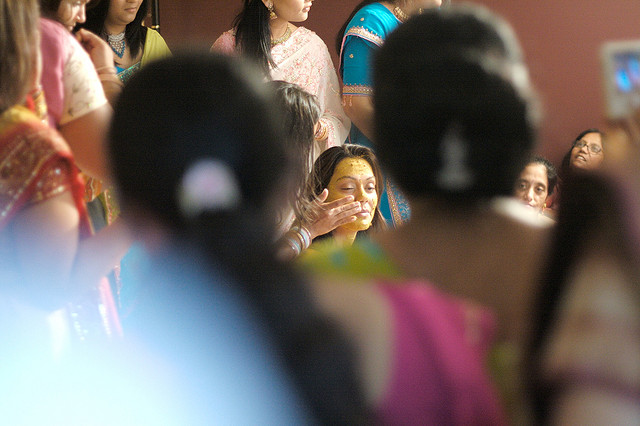
Photo by drewbeck
Pitthi is an auspicious ritual performed for good luck. Pitthi is a paste made mainly of turmeric, chickpea flour and rose water. Family members and well-wishers of the bride and groom apply the paste on the bride/groom's skin. This yellow paste is thought to brighten and even the skin tone and is applied one of the days prior to the wedding ceremony.
The Mehndi event is a colorful and fun celebration held the night before the wedding, which is traditionally celebrated by the women on the bride's side of the family. Generally, a professional mehndi artist or relative will apply henna in intricate designs to the hands and feet of the bride and other women in the family. These intricate designs symbolize joy, beauty, spiritual awakening and offering. The bride's mehendi sometimes goes half way to her knees. There is music, dance and full "Bollywood tamasha!"
The Wedding ceremony:
Indian weddings not only unite Bride and Groom but also their families. Family plays a key role in making life decisions. India is a collectivist culture to the core. The ceremony begins with arrival of Groom.
Baraat (The groom's procession): Accompanied by his family and friends in a festive procession known as the baraat, the groom arrives at the entrance of the wedding venue on a horse. The procession consists of his family and friends singing and dancing around him to music generally played by a professional dhol (large bass drum) player. The baraat is met by the bride's family at the entrance to the wedding venue. It symbolizes the pleasure and happiness of the Groom's family in accepting the bride as a part of their family; as their very own.
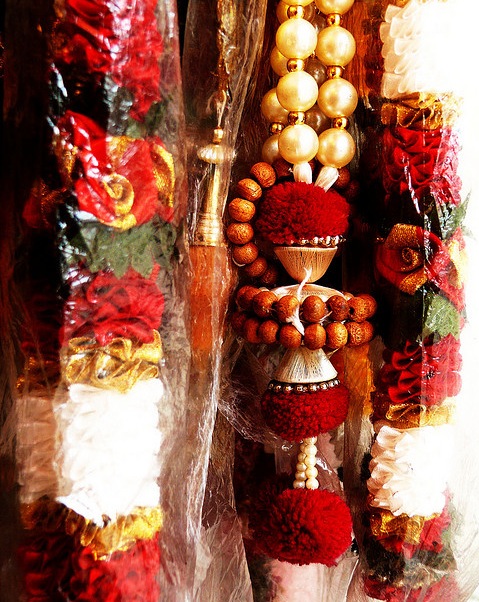
Photo by cleiph
Milni (Meeting of the two families): The bride's mother greets the groom with a welcoming ritual. Relatives of the bride and groom embrace and greet each other with garlands. The bride's family then escorts the groom to the mandap, a canopied altar where the ceremony is performed. The mandap represents the home that the bride and groom will make together.
Ganesh Puja (Prayer to Lord Ganesh): The ceremony begins with a worship of Lord Ganesh, the destroyer of all obstacles. The priest guides the groom and bride's parents in offering flowers, sweets and prayer to Lord Ganesh.
Kanya Aagaman (Arrival of the Bride): The bride enters the hall and is escorted to the mandap by her maternal uncle and aunt, signifying that the bride's maternal side approves of the union. In other parts of India, the bride is escorted by her sisters, cousins and close female friends.
Jai Mala (Exchange of Garlands): Once the bride approaches the mandap, the bride and groom exchange floral garlands, signifying their acceptance of one another.
Kanyadaan and Hasta Melap (Giving Away of the Bride): At this point, the bride's father pours sacred water in his daughter's hand and places her hand in the groom's hand, officially giving away his most precious gift to the groom. The groom's sister or cousin then ties the end of the groom's scarf to the bride's sari with betelnuts, copper coins and rice, symbolizing unity, prosperity and happiness. The knot represents the eternal bond of marriage.
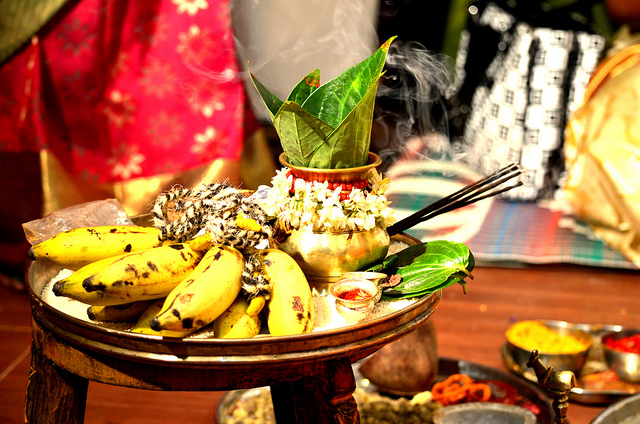
Photo by dahon
Vivah Havan (Lighting of the Sacred Fire): The priest then lights the sacred fire or Agni. Agni symbolizes the divine presence as a witness of the ceremony. Commitments made in the presence of agni are made in the presence of God.
Mangal Phere (Circling the Sacred Fire): The bride and groom walk around the sacred fire seven times keeping in mind the four aspirations in life: Dharma (duty to each other, family and God), Artha (prosperity), Karma (energy and passion) and Moksha (salvation). The bride, representing divine energy, leads the groom in the first three rounds, while the groom leads in the last four rounds, signifying balance and completeness. In some cultures, the bride and groom walk around the fire four times, with the bride leading in the first three rounds, and the groom leading in the final round. The bride's brother places rice grains in her hands after she completes each round to signify his pledge to always support and protect her in times of need. Once the couple has completed the four rounds, there's a race to see who will sit down first. It is said that whoever sits down first will rule the house.
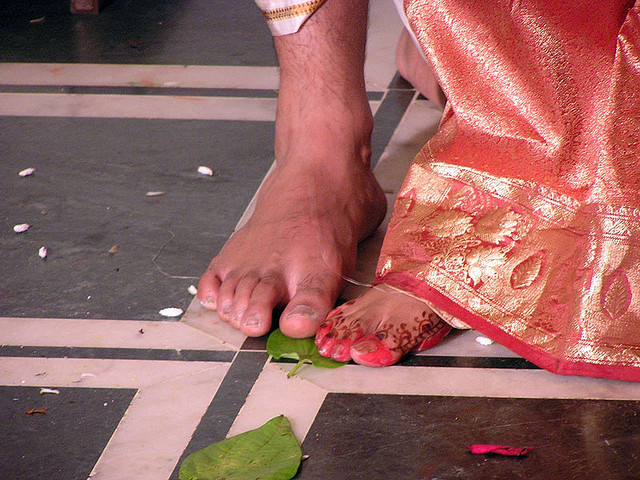
See also

Saptapadi (The Seven Sacred Steps): This is the most beautiful part of an Indian wedding. It has so much depth, purpose and meaning. The couple takes seven steps together, taking a sacred vow with each step:
1. Together we will live with respect for one another.
2. Together we will develop mental, physical and spiritual balance.
3. Together we will prosper, acquire wealth and share our accomplishments.
4. Together we will acquire happiness, harmony and knowledge through mutual love.
5. Together we will raise strong, virtuous children.
6. Together we will be faithful to one another and exercise self-restraint and longevity.
7. Together we will remain lifelong partners and achieve salvation.
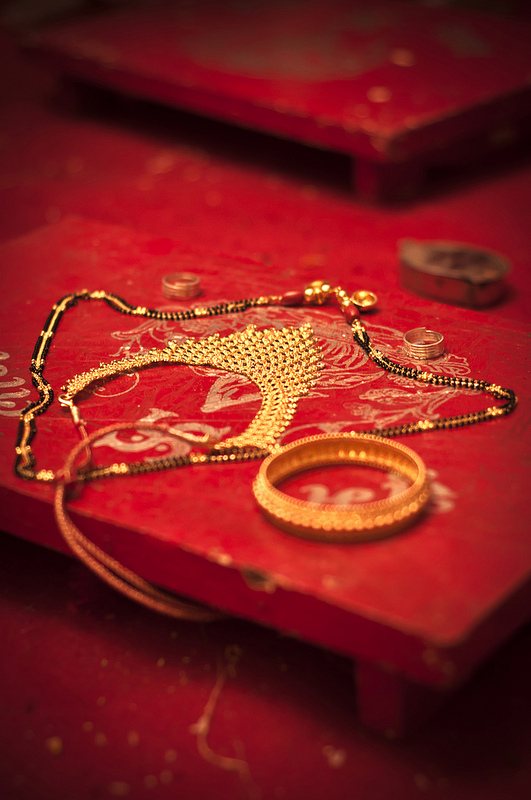
Photo by kunjan detroja
When they return to their seats, the bride will move to sit on the groom's left side, taking the closest possible position to the groom's heart. The groom then offers the bride lifelong protection by placing a mangalsutra, or sacred necklace made of black and gold beads, around her neck and applying sindoor (red vermillion powder) on the crown of her forehead. These two offerings signify the bride's status as a married woman and the grooms devotion to the bride. The bride and groom also exchange rings at this time and feed each other sweets.
Aashirvaad (Blessings for the Married Couple): Women from both families whisper blessings into the bride's ear. The couple then bows down to the priest, their parents and elder relatives to receive their final blessings. The guests shower the newlywed couple with flowers and rice to wish them a long and happy marriage.
Bidaai (Going away of the Bride to the Groom's house) – The bride says her final goodbye to her family and the father gives his prized possession to the Groom's father. The procession ends joyfully, yet is often bittersweet for those closest to the Bride and Groom.
 ABOUT THE WRITER
ABOUT THE WRITER
Divya Patwari is an avid tea drinker who holds a Bachelors degree in Political Science and a Masters in Fashion Management. She is always "˜in pursuit of happiness' and wishes to travel all across Europe. Patwari's studied John Locke and Rousseau, loves Julius Caesar and has a knack for reading minds. She's always in love and welcomes you to join her in finding out the "˜Joie De Vivre' together.
Feature photo, Traditional Indian Wedding Ceremony Rituals by teresalings
bride walking to mandap under mother's wedding dress
Source: https://www.thecultureist.com/2013/05/31/vivaah-traditional-indian-wedding-ceremony-rituals/
 ABOUT THE WRITER
ABOUT THE WRITER